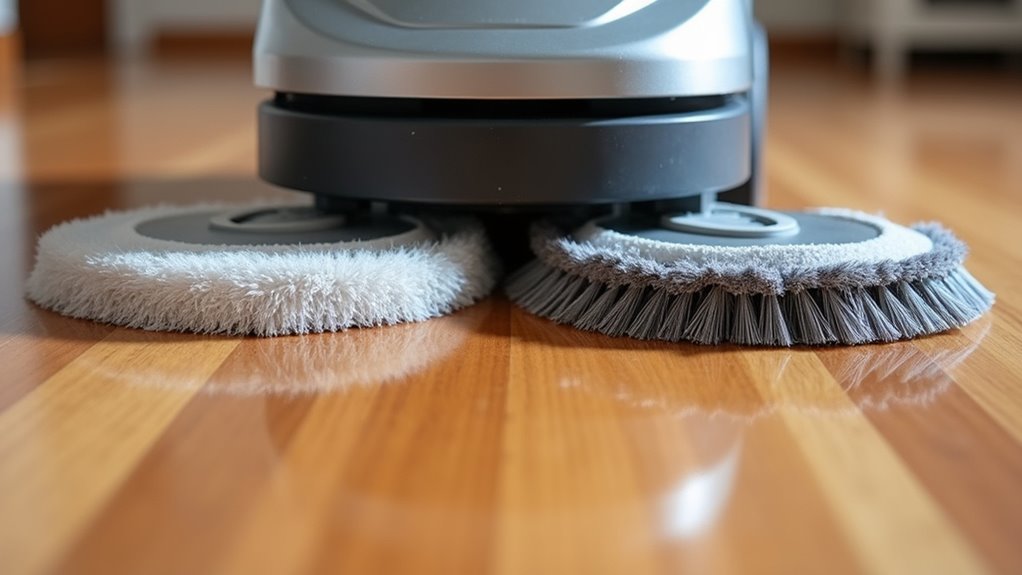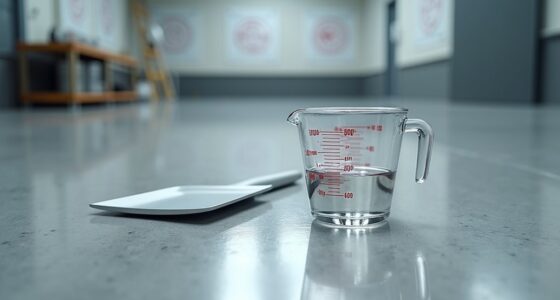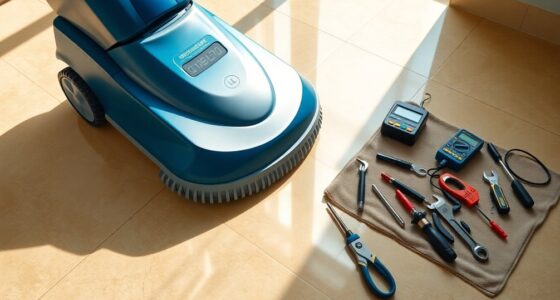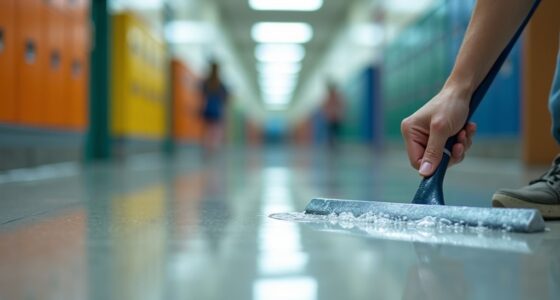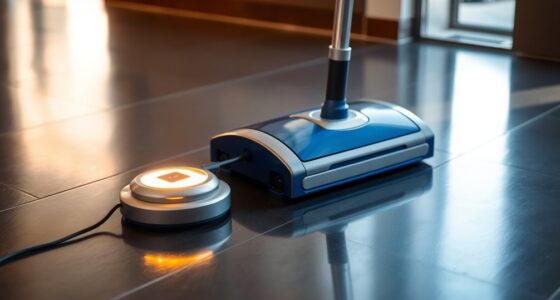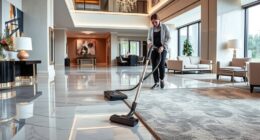When setting up your auto-scrubber for sealed hardwood, choosing between pads and brushes is key. Pads made of microfiber or foam are gentle and ideal for polishing and light cleaning, while brushes with bristles are better for stubborn dirt but may cause micro-scratches if used improperly. To protect your floor’s finish, always test tools first and follow manufacturer instructions. Keep exploring to discover the best setup for your specific floor care needs.
Key Takeaways
- Use soft microfiber or foam pads for gentle, polishing cleaning on sealed hardwood floors.
- Brushes with bristles are suitable for stubborn dirt but risk micro-scratches if used improperly.
- Pads promote even solution distribution and minimize surface damage, ideal for routine maintenance.
- Reserve brushes for deep cleaning of embedded grime, adjusting pressure to prevent finish damage.
- Regularly inspect and clean tools to maintain effectiveness and prevent floor surface harm.

Setting up your auto-scrubber for sealed hardwood floors is a straightforward process that guarantees effective cleaning without damaging the surface. Before you start, it’s essential to focus on two key aspects: battery maintenance and cleaning solution selection. Proper battery care ensures your machine runs smoothly and maximizes runtime, so regularly check and charge the battery according to the manufacturer’s instructions. Keeping the battery terminals clean and avoiding over-discharge helps prolong its lifespan. When it comes to cleaning solution selection, choose a pH-neutral, hardwood-friendly formula. Harsh chemicals can dull or damage the finish, so always opt for solutions specifically designed for sealed wood floors.
Ensure optimal cleaning by maintaining batteries and using pH-neutral solutions designed for sealed hardwood floors.
Once your battery is in good shape and you’ve picked the right cleaning solution, you can move on to attaching the appropriate cleaning pad or brush. This is where understanding the difference between pads and brushes becomes vital. Pads are soft, often made of microfiber or foam, and are excellent for polishing and gentle cleaning. They distribute cleaning solution evenly and lift dirt without scratching the finish. Brushes, on the other hand, have bristles that can scrub more stubborn grime and are better suited for heavily soiled areas. However, using brushes on delicate sealed hardwood can sometimes cause micro-scratches if not used carefully.
When setting up your auto-scrubber, consider the type of debris and level of dirt on your floor. For routine cleaning, a soft pad is usually enough to maintain a clean and shiny surface. If you’re tackling stubborn stains or embedded dirt, a brush with softer bristles may be more effective. Always test a small, inconspicuous area first to ensure the brush or pad won’t scratch or dull the finish. Adjust the scrubbing pressure accordingly, especially when using brushes, to prevent damage. Additionally, choosing appropriate cleaning tools that are gentle yet effective can help preserve your hardwood’s appearance over time.
Another important factor is the machine’s water flow and solution dispensing settings. Too much solution can leave residue, while too little might not clean effectively. Follow the manufacturer’s guidelines for your specific model, adjusting the settings based on the level of soil. Regularly inspect and clean the pads or brushes after each use to prevent dirt buildup, which can cause scratching or streaking on your hardwood. Proper maintenance of the equipment, including battery care and choosing the right cleaning solution, guarantees your auto-scrubber works efficiently and keeps your sealed hardwood floors looking their best.
Frequently Asked Questions
How Often Should I Replace the Scrubber Pad or Brush?
You should replace your scrubber pad or brush when you notice signs of wear, such as fraying or reduced cleaning effectiveness. Typically, follow a regular replacement schedule based on usage; for instance, every 50 to 100 hours of operation or monthly, whichever comes first. Monitoring the scrubber lifespan helps guarantee peak cleaning performance and prevents damage to your sealed hardwood floors. Regular replacement keeps your equipment functioning efficiently and extends its overall lifespan.
Can I Use the Same Setup for Different Hardwood Finishes?
You shouldn’t use the same setup for different hardwood finishes because finishing types and surface textures vary. Soft finishes like polyurethane need gentle pads, while more textured surfaces may require brushes to clean effectively. Switch between pad and brush depending on the specific finish and surface texture to avoid damage and guarantee thorough cleaning. Adjusting your setup helps you maintain your hardwood’s appearance and longevity.
What Safety Precautions Should I Take During Setup?
Sure, safety gear isn’t just for dramatic effect—it’s essential. You should wear gloves, eye protection, and non-slip footwear to prevent hazards. Always check your surroundings for obstacles and make certain of proper ventilation. Be aware of wet surfaces to avoid slips. Remember, hazard awareness isn’t optional; it keeps you safe as you set up your auto-scrubber. Prioritize safety gear and stay alert—your health’s worth the extra effort.
Is There a Recommended Cleaning Solution for Sealed Hardwood?
For sealed hardwood, you should use cleaning agents specifically designed for wood surfaces to guarantee effective cleaning without damage. Opt for gentle, pH-neutral solutions that protect the surface and prevent stripping the finish. Always test the cleaning agent in a small, inconspicuous area first. This helps maintain surface protection and prevents any adverse reactions. Regularly check the manufacturer’s recommendations to choose the best cleaning solution for your sealed hardwood floors.
How Does Setup Differ for Large Versus Small Areas?
Think of your cleaning setup like tuning a guitar; the size of the area influences your adjustments. For large spaces, you’ll want a wider pad or brush, and set the machine to cover more ground quickly. Smaller areas require more precise equipment adjustments, with narrower attachments and slower speeds for careful cleaning. Always adapt your auto-scrubber setup based on the area size to make certain of effective, efficient results.
Conclusion
So there you have it—whether you choose a pad or a brush, just remember, the real secret to shiny, sealed hardwood is pretending you know what you’re doing. With the right setup, you’ll impress your friends with your cleaning prowess—until they see the streaks or hear the squeaks. But hey, at least you tried! After all, who needs perfection when you’ve got a shiny floor and a good story about your auto-scrubber adventures?
